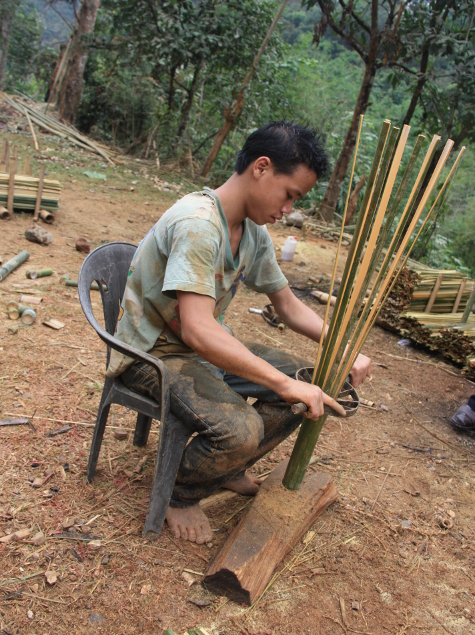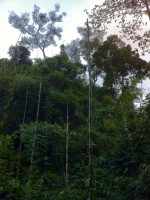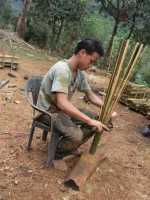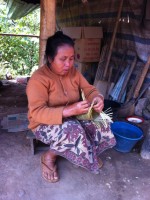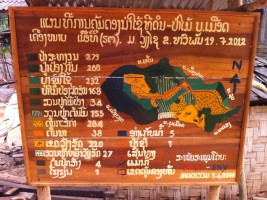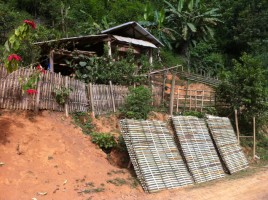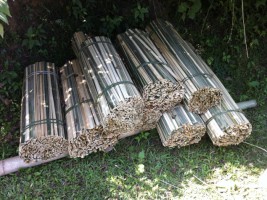Development of the bamboo processing sector
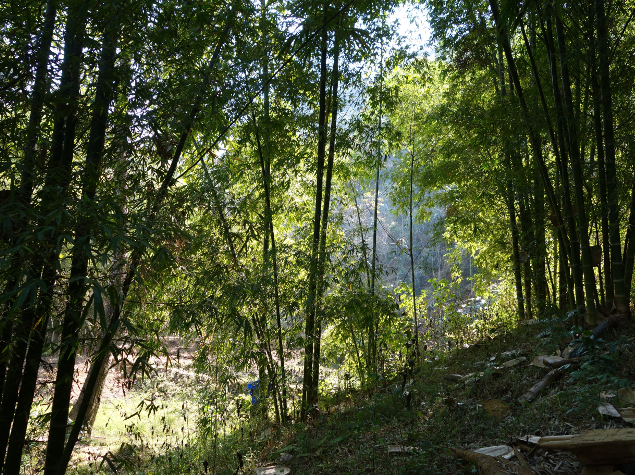
Houaphanh is the poorest province in northern Laos, with per capita GDP ranging from $50 to $200 in 2002 (the national average was $350), despite having abundant bamboo resources attracting the investors’ attention.
In order to develop these resources sustainably, GRET (Groupe de Recherche et d’Echanges Technologiques) set up a project aimed at diversifying and increasing the incomes of even the poorest local communities in remote areas, while at the same time conserving natural resources and enhancing forest management.
The project targeted stakeholders in the bamboo sector: producers (individuals or groups, the project supporting the setting up of such groups), collectors (at district and provincial level) and those involved in pre-processing and processing (support for the establishment of workshops at production sites).
To implement the project, the GRET teams’ first objective was to support the emergence and development of small-scale bamboo processing workshops, creating jobs as close as possible to production sites and added value for the villages.
The aim was also to develop trade relations, to facilitate networking between local micro-businesses, to provide training in bamboo processing for these micro-businesses, and to raise awareness of the need to respect the environment.
The project outcomes and their indicators were as follows:
- 3 sustainable bamboo value chains, supported by Fondation Ensemble, have been developed (90%):
- dried edible bamboo (hok) shoots;
- handicrafts/basketry: baskets for glutinous rice, shopping bags, etc.;
- slats for the manufacture of blinds, chopsticks, table mats, incense sticks, etc.
- 36 bamboo collection and pre-processing groups are in operation. (90%)
- 4 pre-processing workshops with collective equipment, salaried staff and entrepreneurial management are in operation. (100%)
- 34 groups have regular business relations with traders. (85%)
- 1 353 families have a stable additional income of around 150 euros per annum. (200%)
- Plans for a service center, handbooks and posters have been prepared in order to enhance vocational training in the related sectors. (80%)
- 28 village technicians have been trained in handicrafts and in the planting and monitoring of bamboo forests. (280%)
In parallel, the GRET teams aimed to develop and adapt forest management so as to pursue new market opportunities for bamboo products (to enable the processing workshops to be supplied with sustainable raw materials). The outcomes and indicators are as follows:
- 28 land management plans (140%) and 17 forest management plans (85%) have been approved by the district authorities, and 30 villages have forest management plans that are monitored annually. (150%)
The project has delivered very good results, which are promising for consolidation and extension. The local authorities are closely involved in policy decisions. The financial returns for the beneficiaries are already substantial, and the forest resources are beginning to be managed sustainably.
Sustainability of the actions undertaken:
Extract from the final evaluation carried out by Paul SFEZ in August 2015
- Efforts to ensure the sustainability of the actions are well underway and promising.
- At village level, the bamboo forest management has been trialed and is now established thanks to the support of the village authorities and the existence of producer groups that have acquired skills for management, producing, processing and trading. The increasing acceptance of rules and regulations and the expectations of Communal Land Registration and Titling are illustrations of village ownership of the bamboo resource management established by the project. Service providers have the know-how to operate at the technical level and to meet the growing demands for services from other villages and projects. The bamboo development funds give some financial sustainability to cover the costs of forest management and trading. Nevertheless, producer groups (PG) still need reinforcement, particularly on forest monitoring, governance, record-keeping, financial management and negotiation skills, as well as on transparency. Furthermore, the economic sustainability of the PG is threatened by the gap that exists on rules and current operations between villages covered by the project and other villages. Indeed, the collection of fees, established to ensure the financial sustainability of forest management and business activity, is leading the traders to redirect their purchases to villages where fees are not charged. Particularly in the handicraft value chain, where there is considerable competition between traders, villagers face difficulties in collecting fees from non-registered traders.
- Although activation of business activity in 4 value chains (including the 3 supported by Fondation Ensemble) has given good economic results, access to the market is still fragile. The dried hok shoots market in Vietnam is not widely known, and access to both the Vietnamese and Chinese markets suffers from the operations of Chinese traders, who still impose drying techniques on the producers that use sulfur, which poses a high public health risk in the export markets with potential negative effects on the value chain in Houaphanh Province. The domestic market for this product outside Houaphanh Province is still not greatly developed. The trialling underway of a Participatory Guarantee System (PGS) with several hok shoots producer groups, with the support of the International Federation of Organic Agriculture Movements (IFOAM), seems a good option to ensure market access.
- The capacity of the provincial authorities to test policies for activating the bamboo sector is also an important factor for the sustainability of the initiative. The revision of quotas and tax policy is still a challenge for future development of the bamboo sector (as well as for other sectors).
- The validation of the Provincial Bamboo Strategy 2016-2020 bodes well for the future.
Conclusion :
Extract from the final evaluation carried out by Paul SFEZ in August 2015
- The combination of territorial and business approaches organized around the components of land management, forest management, plantations, business and trade, and an enabling environment, in the framework of the Provincial Bamboo Strategy 2011-2015, with a participative and inclusive multi-stakeholder approach, has ensured high relevance for the project.
- The high effectiveness is due to good outcome delivery with an excellent use of the collective learning process and numerous collaborations and exchanges with other projects and national fora. This has resulted in significantly increased income (average annual income of $166 per household) and job creation from a side activity. The first steps in bamboo sector structuring have been taken, through increased sustainable management of the bamboo forest, largely served by a mix of small-scale enterprise activity and widespread growth of cottage industry.
- Finally, the evaluation strongly recommends a second phase in order to consolidate, extend and deepen bamboo sector development in Houaphanh Province.
Conclusions from the ex-post visit (May 2018)
The sustainability of this project, whose relevance has been beyond the initial investment period and whose main outcomes have largely exceeded the initial objectives, is the result of the long-lasting organization of villagers in “bamboo village committee”, for the management of the forest on one hand, and “producers’ group”, for the marketing of bamboo production, on the other hand. But the most obvious expression of sustainability of the project is the establishment, at the end of 2017, of the Bamboo Non-Timber Forest Products Development Association (BNDA) which aims to become a national platform for bamboo to implement a national bamboo strategy.
By the end of 2017. 4.950 hectares bamboo forest were allocated to 29 villages; 2.800 households in 73 villages were engaged in 5 bamboo sectors generating an additional income of USD 200 per household in 2017. Finally, the actions undertaken since 2011, with the support of GRET, have ended in results of excellent quality as regards management of forests and bamboo plantations; creation of commercial channels; increased income for village communities; structuring of dialogue forums between the actors (at the village, district, provincial and, in the near future, national level).


